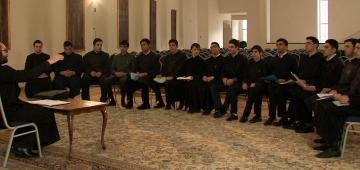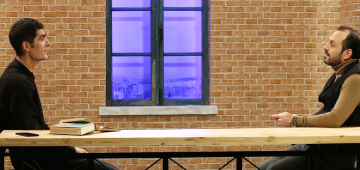 |
"Echmiadzin" ChoirThe "Echmiadzin" Choir of the Gevorgyan Theological Seminary was created two years ago, managed to measure its strength at the international festival and take a prize place. The 16-person polyphonic choir consists of second through sixth grade students. In addition to spiritual works, the boys also perform classical and folk works. |
 |
Within one story. Perch Zeytuntsyan "One of every ten"
Perch Zeytuntsyan is better known as a novelist, his plays are also known.
However, few people know that Zeytuntsyan wrote short stories, especially in the early creative years. Zeytuntsyan's 1956 The first book he published, "His First Friend" is a collection of short stories. The 3 books that follow it are also collections of short stories.
On the "Parallel Readings" program, literary critics Hayk Hambardzumyan and Arkmenik Nikoghosyan discuss Perch Zeytuntsyan's story "One of Every Ten".
|
 |
Reed flute cut. M. Metsarents "I will be, I will be"
Misak Metsarents' "I'll be, I'll be" series of the "Nor Tagher" collection includes only three poems, but it is not only well-known and loved, but also received various comments. Why did the author single out such a series? Couldn't his other works find a place in that series? Literary experts Hayk Hambardzumyan and Arkmenik Nikoghosyan discuss the works of the Western Armenian poet.
|
 |
About one story: A. Bakunts "Alpine Violet""Alpine Violet" by Aksel Bakunts can be understood and interpreted in different ways. Is the story about the perception of beauty, or perhaps the clash of old and new times, or does the author raise social issues? In the "Parallel Readings" program, literary critics Hayk Hambardzumyan and Arkmenik Nikoghosyan discuss the most famous and popular story of Armenian literature. |
 |
Erik Mkrtchyan after the 44-day war
The ill-fated ATS strike in Jarakan changed the life of Erik Mkrtchyan. He and his family moved from Vanadzor to Yerevan so that he could receive long-term treatment first in the hospital and then in the "Soldier's House". Eric now considers that after being injured, he appreciates life, his relatives and the world around him. He believes that difficulties have made him stronger.
|
 |
Aram Terzyan after the 44-day warThe prayer book saved the lives of father and son Terzyans during the 44-day war, Aram Terzyan's life was saved by the pocket prayer book and cross. The enemy's bullet hit the prayer book of the pocket-pock, which protected Aram like a bulletproof vest. The same prayer book also protected Aram's father during the first Artsakh war. After being treated in the "Soldier's House", Aram donated the prayer book to the chapel opened in the rehabilitation center. Now Aram is the coordinator of "Soldier's house" in Shirak region. |
 |
The modernity of "Narek"How is "Narek" relevant today, how can it help our people and Christians all over the world today, what ways of life does the "Book of Tragedy" written in the Middle Ages indicate? Literary critics Hayk Hambardzumyan, Arkmenik Nikoghosyan and ethnographer Arusyak Tamrazyan talk.
|
 |
Edmond Hovakimyan after the 44-day warHe had been demobilized months earlier when the 44-day war began. He went to Artsakh as a volunteer with his friends. On October 11, he lost his left arm in a drone strike in Jabrail. He was engaged in music for nine years. Clarinet, shwi, duduk, pku; these were not just musical instruments for Edmond, but, as he says, the greatest loves of his life. The hardest part has been adjusting to the thought of not playing forever. Today, Edmond is a famous showman. It has its own myth-he believes that the day will come when he will have a hand again. "When you see the kind of scientific and technological growth our planet records every day, you believe that after ten to fifteen or maybe twenty years it will be possible to get a hand again through surgery," he says. |
 |
Christmas according to hymns and versesSharakan or hymn is the main type of our spiritual-ecclesiastical music, at the same time, it is one of the oldest genres of Armenian language poetry. The authors of ancient examples of hymns are Mesrop Mashtots, Sahak Partev, Movses Khorenatsi, Hovhan Mandakuni. Many of our hymn writers wrote hymns dedicated to Christmas, the first and great holiday of the Christian year. These works are dominated by the inspiring and festive mood of the Savior's birth, the motifs of admiration for the Holy Mother of God and Baby Jesus. The hymns and gospels of Christmas are discussed in "Parallel Readings" by literary experts Hayk Hambardzumyan and Arkmenik Nikoghosyan. |
 |
About one story: Levon Bashalyan, "Kaghand"Christmas or "kaghand" stories were popular and widespread in Western Armenian reality until the 10s of the 20th century. New novelization began each new year with "kaghand" novels. The first works of the year published in the press of the time, in accordance with the recommendations of the holidays, discussed benevolence, compassion, brotherhood, mercy towards the poor and oppressed, repentance and conversion, new beginning and renewal of life, as well as national themes. Levon Bashalyan's "Kaghand" is such a cozy story. Literary experts Hayk Hambardzumyan and Arkmenik Nikoghosyan discuss the story. |
 |
Derenik Demirchyan's Armenian
Derenik Demirchyan's essay "Armenian" was first published in 1920 in the press. Later, it was included in the 14th volume of the author's works, but "scissored". The essay differs thematically and in tone from Demirchyan's other works and raises many questions. Literary critics Hayk Hambardzumyan and Arkmenik Nikoghosyan discuss the essay "the Armenian" in "Parallel Readings".
|
 |
About one story. Susanna Harutyunyan, "The Howl of Female Winds"
Novels, short stories and short stories of prose writer Susanna Harutyunyan are remarkable for the topics they discuss, not so "feminine" perspective, psychological subtleties of character creation. S. Harutyunyan's story "The Howl of Female Winds" is discussed in "Parallel Readings" by literary critics Hayk Hambardzumyan and Arkmenik Nikoghosyan.
|
